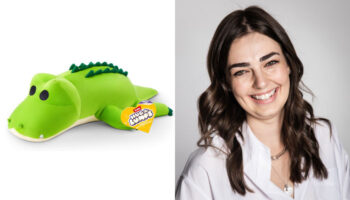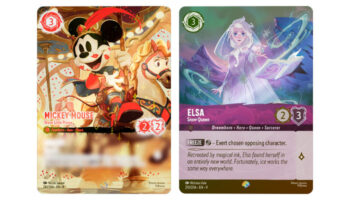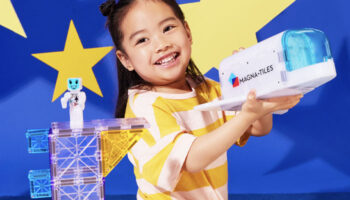Prolific inventor Peggy Brown discusses why she doesn’t see creativity as an art… Or a science

Thanks for joining us Peggy – it’s been a long time in the pipeline. Let’s start early doors… Growing up, with which toys and games did you tend to play?
I didn’t have many toys beyond jump ropes and superballs, a few standard games like checkers and bingo, and a couple stuffed animals. Once in a while we had some fad thing like a Lemon Twist or Ker-Bangers, but mostly, I made stuff. My mom was a schoolteacher and took care that I had all the supplies and tools I needed to make whatever I wanted to make. Lots of coloured paper and glue and those kinds of things, but I played by making things more than I played with particular things.

Santa brought me paints and fabrics and pipe cleaners and clay. He even brought me a sewing machine when I was seven, and I still have it – we use it to this day at the studio to make plush prototypes. As kids, I played outside a lot with my siblings and the neighbourhood kids. We played games like Kick-the-Can and Four Square, Freeze Tag, Ghost in the Graveyard and Bloody Mary. We playacted whatever was popular at the time, like Olympics when Nadia Comaneci was on the balance beam, and Charlie’s Angels when it was the hot show on TV. We had so much fun outside, inside our imaginations!
How did you get into the industry?
I studied Industrial Design in college, and being from the American Midwest, much of the local industry involved motor sports, automotive, farming and mining equipment, and tools. All of that was interesting in a design sense, but also nearby was Western Publishing, which was a hundred-year-old publisher and manufacturer of books, games, baseball cards, colouring books… They had the largest sheetfed printing and die cutting presses in the world and were the global leader in jigsaw puzzles. Many of their products were made right on the wooden factory floors not 30 miles from where I grew up in Milwaukee. I still remember the delicious inky smell of the place. Western was also a pioneer in licensing – they published Little Golden Books and Big Little Books, which were some of the very first products in the world to partner with IP creators – like Walt Disney himself.

From their game department came some important and lasting products like Girl Talk and Outburst. After graduation I was hired there as a product designer in the game department, which was perfect for me because the job included non-physical aspects of design that interested me, like story, copywriting, and the social aspects of products. We designed not just the physical parts of products, but the ways people used them. We designed the way kids and families interacted with each other around the products. I learned a lot there, even though I stayed less than three years. I left Western when I was twenty-three to open a design company called Alley Oop. Got started with a set of Prismacolor markers and a hundred bucks, and grew to a staff of eight or nine designers and illustrators over eight years, supplying art and design work to lots of toy and game companies.
When I research inventors, I usually, look at all their ideas to get a feel for who they are… But in your case, there are WAY too many! Let me ask you this: if you had to pick three that represent your personality, to which three would you point? And why?
Everybody asks me this or asks which of my creations is my favourite, and I never know how to answer. Ummm – I guess I prefer to make things that give kids and families something to aspire to rather than to just entertain them. But I think that can be anything – depending on how they use it. It’s funny – we inventors don’t always get to hear exactly how our work affects its users. We know it’s selling, and people are interacting with it, but we can’t know the emotional attachments, the memories, stories, and the nuances of the experiences people have with and because of our work. We just have to believe that we’re making an impact, but it’s opaque and mysterious. I hope this was a sufficient distraction from having to name three products, because I can’t.

The very first word on your website is ‘creative’. Do you see creativity more as an art or a science?
I think of creativity as neither an art nor a science, but rather, as a skill. Typically, describing somebody as “creative” is often attached to a notion of how lucky they are to have been born with a magical indefinable ability to conjure wonderful things, which completely neglects the enormous amount of work involved. Yes, one must have an innate propensity toward creativity, but to me, being creative means to be vigilantly curious, initiate the hunt for fascinating and relevant things, be able to identify them when you find them… That is HUGE because most people unconsciously pass them by! Also, to gain, collect and amass knowledge, and to spend a lifetime in practice.

Yes, creativity involves art and science, but there are so very many more aspects and layers to it. It’s not just a flash of insight out of thin air. It’s actively dismantling the status quo – or the toy market – to find bubbles of open space and then calculating how to fill them. It’s cleverly circumventing the obstacles on the path despite what hobbles you, and it’s a relentless task of drawing from all these different sources to combine common and often utterly mundane elements into something exciting and new. I also think creativity is a muscle – the more you stretch and flex it, the stronger and more elastic it becomes. It’s a muscle with memory too – it stores all these experiences. And the nimbler your creative muscle is, the more quickly and easily it delivers sparks and solutions.
What kind of things do you do when you’re stuck for an idea? Do you keep a notebook? If I asked you to walk you through your process, what would you say?
I don’t get stuck for ideas. At least extreeeemely seldomly, and not for long. I don’t keep a notebook – I’m really bad at notes! Sometimes I jot things down on scraps or on paper placemats from the diner which I crumple up, stuff in a folder and forget to ever look at again. My process – in a much more organic way than this is going to sound – is to define the problem that needs solving, then run at it from various angles, bounce it around, and take the nuggets gleaned from these gymnastics and combine them.

I’m a pragmatic thinker, which some might presume is antithetical to creativity, but I find it’s extremely useful to set the parameters early. Once I define the ballroom, I dance like crazy in every single inch of it, and I don’t waste moves that can only be done outside… I accept the walls, the boundaries, which often translate into solutions that are planted firmly within the given criteria, which are basically the realities of commerce. Sure – all kinds of ideas squirt out through the doors and windows, but experience has taught me how to collect and save those gems and apply them to other projects. No ideas are useless or go to waste, but sometimes they’re irrelevant to or unrealistic for the matter at hand, so they hang in limbo until they’re just right to click into something else. I also say nothing is ever completely for waste because it can always be used as a bad example! And of those, I have plenty.
What would you consider creative Kryptonite? What stops Peggy Brown being creative?
Paperwork and emails.
You don’t work entirely on your own, do you, Peggy? You have a team?
Yes – we have a fantastic group of creatives, and operate out of a funky 100-year-old bungalow that was originally a corner store called Tippecanoe Grocery. The main studio is in the front; it used to be full of flour sacks, canned goods and pickle barrels! We have offices, the conference room and prototype room in the back where the family who ran the grocery store lived.
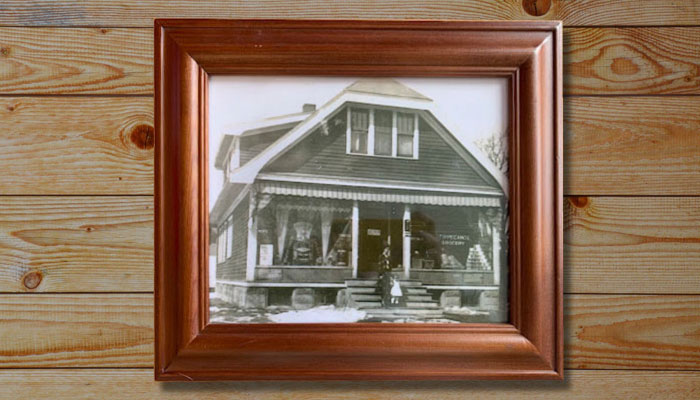
We all cover about six jobs each. Miranda Branley handles illustration, videography and video production, graphics, character creation and all kinds of visuals. Connor Kriha handles most aspects of product design, 3D printing and laser cutting, plush design and construction, and Solidworks. Kim Henry does graphic design, illustration, packaging and product concepting for specialized markets. Marty Brown does game content writing, database management, financial management, and I do a bit of just about all of that plus customer contact, managing presentations and pitches and the administration of the business.
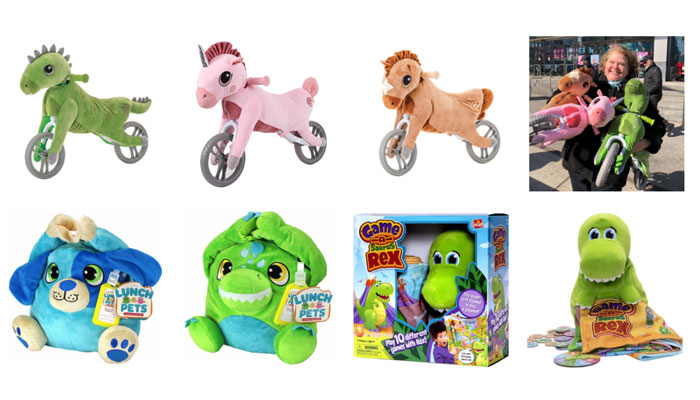
We all do concept generation, product development, prototyping and playtesting, and we all work on whatever is the hottest potato at the moment, which shifts constantly between pure self-started inventions and contract projects that come in – we do quite a bit of writing and development work for many toy, game, and app companies globally. We develop products for the housewares and direct-response markets too.
If you had your career all over again, what advice would you give yourself starting out?
I’ve been at this long enough to understand the enormous amount of luck it takes. Luck absolutely favours the persistent, but anybody who claims they’re successful at this without acknowledging the good fortune of certain happenstances, education, generous mentors and partners along the way, and necessary funding, well, they’re not telling the whole truth. To answer your question, I don’t think I would have any advice for my younger self other than to keep on trying and ignore the bullies. I didn’t need that advice because I learned it on the playground before my baby teeth fell out. I had a publisher who once told me, after a crushing defeat on a project, “Peg, don’t let the bastards get ya down.” This was as solid and useful advice as I could ever give anyone, and I apply it liberally to pretty much everything.

What’ve you worked on recently that you’re keen to highlight?
There are always about 20 or 30 product inventions on the front burners, but I also like to make things that aren’t games and toys. I presently have a number of ambitious not-toy-related projects in process including writing a series of novels – with accompanying toy lines, of course! I’m also developing a musical. That’s forcing me to learn how to write music, which I know nothing about! There are some artworks in a variety of media just for myself, and I’m dying to get back down the basement into my hot shop to blow glass – mostly lampwork; torchwork. At one point years ago I wanted to make custom marbles for a game, and started experimenting with hot glass. It’s a meditative process that results in delightfully surprising outcomes and takes your full concentration or else you burn your eyebrows off. Needless to say, I like to dabble in a variety of disciplines. Ok, I’m compelled to try things.
If you were to write your autobiography, what would you call it?
I seriously wouldn’t take the time to write my autobiography because then I’d have to read it in order to copyedit it. Ugh. No way.
Finally then, what’s the most interesting thing in your office or on your desk?
Ooo! I just got a purple and orange Nerful on a trike from ebay. It makes me happy.

–
To stay in the loop with the latest news, interviews and features from the world of toy and game design, sign up to our weekly newsletter here








